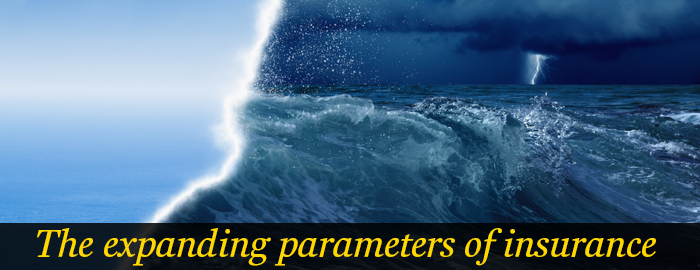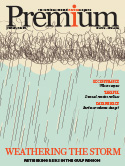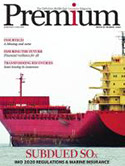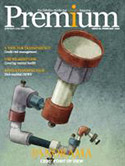The Expanding Parameters of Insurance

Parametric insurance is a potential gamechanger in increasing the penetration of insurance in sync with traditional products, argues Suresh Nair.
Take a few moments to consider the following.
Scenario 1: Floodflash, a UK-based Lloyd’s cover holder provides specialised flood cover for properties. Sensors are supplied, for this purpose, by Floodflash to their customers for installation at the insured locations. This sensor detects flooding and in the event of flood waters reaching beyond a preset level mark, the claims process gets triggered automatically with no need for the customer to intimate the claim to the insurer as followed in the traditional process. Furthermore, there is no documentation requirement as seen in a normal insurance claim. Based on the data transmitted by the sensor a pre-agreed payout is made to the customer’s bank account. In February 2020, Floodflash set a record by settling a property flood claim in 26 hours and 15 minutes during Storm Ciara. In January 2021, during Storm Christoph, Floodflash upped the ante by beating their own record and settling a claim in 9 hours and 44 minutes!
Scenario 2: For the wine industry, during the growing season temperatures below a certain level for extended periods adversely affects production. The quantity of grapes available for harvesting can be lower. The quality can also be affected which in turn impacts the quality of the wine. As a stray example, in 2017, the Bordeaux region in France which is famous for its wine saw a reduction in the production by 40 percent due to frost. Vineyard owners may face increased costs for staving off the frost including novel methods like hiring helicopters to hover above the crop to create warmer air currents. The reduction in quality and quantity along with increased costs have a huge adverse effect on the industry. Apart from the wine manufacturers, supply chains both upstream and downstream can also have their revenues getting impacted. AXA Climate in France developed a frost protection coverage which guarantees the insured customer a pre-determined payout in case the temperature drops below a certain level for a certain period. With no loss adjusters required the reimbursement process can be completed very fast and substantial recoveries can be made by the Insured to minimise their losses. Recently the same issue had the French government calling an emergency meeting with bankers, insurers and agricultural representatives to identify additional support mechanisms, according to an article in CNN.
Scenario 3: Insur8 is a typhoon warning insurance product backed by Swiss Re Corporate Solutions for businesses in Hong Kong. Typhoon warnings can force businesses to shutter down activities, and this in turn, can cause business interruption losses due to the closure or suspended operations. The economic impact has been estimated at USD627 million per day and historical records indicate around four such warnings in a year. The scale of such losses can be devastating and generally fall into gaps of existing property damage and business interruption policies. The Insur8 product makes a payout based on a typhoon warning above signal 8 issued by the Hong Kong Observatory.
All of the above are examples of Parametric insurance at work. Parametric coverages have been in existence in some form or other for the past 30 years be it by way of natural catastrophe reinsurance, weather derivatives or even in some micro insurance programs. In more recent times, Parametric insurance has become increasingly available at the retail level to customers. Big data, Internet of things, better connectivity, increase in computing capabilities have all helped in fueling this availability.
Increasing the insurance bandwidth
Citing a Swiss Re estimate, in the year 2019, the economic losses arising out of natural and manmade disasters amounted to USD140 billion. Of this only USD56 billion (40 percent) was covered by traditional insurance. Parametric insurance can provide solutions in areas traditionally considered uninsurable and thus opens new markets for insurance industry. For its customers it offers another risk management tool. The structure also attracts capital from non-insurance areas like hedge funds, banks etc. It also serves as a very handy tool for governments in dealing with extreme weather events and crop failures. Similarly, for NGOs, this is the ideal solution for disaster relief during natural catastrophes as payments can be paid to those affected even as the catastrophe is taking place. Overall, the advent of Parametric insurance is a win-win proposition for the insurance industry, its customers as well as other stakeholders. Parametric insurance is widely expected to increase the current bandwidth of insurance and in a way change how insurance is done over the next decade.
The metrics
Parametric insurance can be simply defined as an insurance contract which pays out when a pre-agreed event parameter is crossed. The events themselves need to be fortuitous, should be amenable to being modelled and finally have a link to the Insured’s financial fortunes. Subject to this the metrics can range from floods, weather disturbances, earthquakes, power outages, market indices, crop yields to name a few. In more complex products, a combination of these events can also be used. An example quoted by sources at AXA Climate says that while the primary metric for solar energy plants are satellite solar radiation data, high temperature which is known to make solar plants less productive is also used in conjunction with radiation data to make the coverage even more relevant.
Key differences
Parametric insurance differs from traditional insurance in some key respects. Swiss Re underlines one of the main variances saying that it is ‘a type of insurance that covers the probability of a predefined event happening instead of indemnifying actual loss incurred. It is an agreement to make a payment upon the occurrence of a triggering event and is detached of an underlying physical asset or piece of infrastructure’. Insurance traditionally covers property damage and business interruptions emanating from property damage due to insured events occurring. Parametric insurance, on the other hand, covers economic losses out of the insured event happening as evident from the examples listed at the beginning of the article. Equally relevant is the difference in the quantum of the payout. Traditional insurance, for most part, seeks to indemnify the exact amount of the loss suffered by the insured. In principle, if the system works as intended, the insured should neither make a profit or loss from the insurance payout. Parametric insurance, however, works based on a predetermined level of payout. This payout can be further calibrated to vary with the magnitude of the event. For example, the policy can specify ascending levels of agreed payout for earthquakes of increasing intensity on the Richter scale. With such a system, it is possible that the insured cannot fully recover the losses out of the policy i.e., the losses are higher than the payout. Equally it is possible that the losses can be below the specified payouts.
This leads into another deviation from the traditional insurance practices. As there is no need to quantify the loss, the need to go through the claims process of assessment, adjustment and negotiation are all rendered obsolete. There is no need for documentation or the need to establish the exact quantum of the loss actually suffered which are key friction points in the traditional insurance claims process. The transparency and independent verifiability of the event removes any element of bias and brings in greater visibility into the process. With chances of moral hazard being eliminated due to transparency of the entire process there is no need for investigations.
Benefits
For the customer, this results in a much more expedient, efficient and streamlined claims experience. The time frame from the event occurring to receiving the claims payout can be a factor of hours compared to weeks or even months with the normal insurance process.
In certain cases, the Insured can get the claim payout during or even before the loss occurring. For example, it has been found that millions of low-income residents in Florida are often

Suresh Nair, executive director, Gargash Insurance
stranded because they cannot afford the cost of escaping an imminent hurricane. In response, Exante a pioneering insuretech company, has developed a predictive hurricane insurance cover for crisis preparation and evacuation. Based on live information from meteorological departments customers will receive funds into their credit card account in advance and sometimes up to three days before the landfall. This can literally be the difference between life and death for many people and such situations are replicated the world over in different ways.
For the insurer, Parametric insurance products translates into vastly shortened claims cycles and reduction in administration costs. With liabilities being capped, Insurers know exactly the extent of their liability. The nature of the coverage accorded by Parametric insurance means that complex policy wordings (and expensive lawyers to subsequently interpret them) are no longer required. The underwriting process is simplified resulting in substantial reduction in costs for Insurers in this area also.
On Captain Kirk’s path
Parametric Insurance ‘boldly goes into areas’ where traditional insurance does not dare, due to which customers can look forward to solutions to some hitherto non insurable risks. This opens out the range of discussions a broker or insurer can have with the customer. Parametric offerings can even be bundled with traditional offerings wherein the first phase of the claims payout is triggered automatically while subsequent payouts are subject to the usual adjustment and indemnification process. The possibilities of the areas in which Parametric insurance is applicable and /or can be applied seems to be limited only by the constraints of creativity.
Some of the inherent challenges which stakeholders find with Parametric insurance, in its current form, include the following:
- For the buyer, Parametric insurance tends to be more expensive at times than the traditional catastrophe variety and therefore a more careful evaluation of the economic benefits must be carried out.
- There is always a possibility of the payout being lower or higher than the actual loss which means that when viewed from the traditional insurance prism, either the customer or the Insurer may consider themselves disadvantaged.
- Accumulation risks – insurers need to keep careful track of accumulation of values.
It is reasonable to expect such issues to be resolved with progress of time and increase in business volumes.
Parametric insurance is clearly not a replacement or substitute for traditional insurance. It is rather a very good complementary offering to traditional insurance and synced together can be of much greater benefit to the customer, the insurance industry and other stakeholders.
Read More:





































